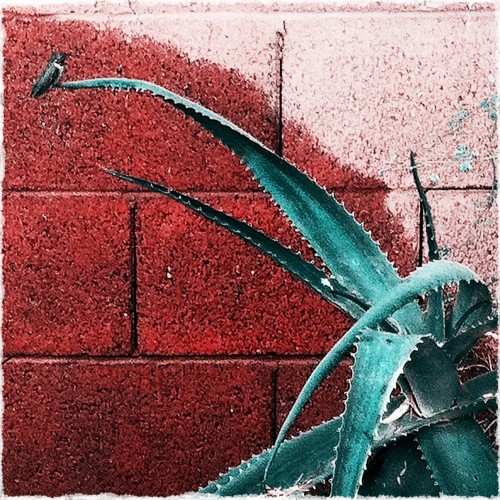What happened at Beit Bat Ya’anah: part 12
This is the twelfth installment of a series. There’s a link at the bottom of the page to the thirteenth installment. Read Part 11 by clicking here, or start at the very beginning by clicking here.
Previously:
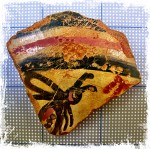 After encountering an anomalous fragment of pottery decorated with a bee and a possible flower, the Beit Bat Ya’anah staff were hotly debating its origins. Leaving them to it and wandering out across the moonlit compound, Professor Wayfarer had recalled a fragment of poetry with a similar motif, causing her to wonder who the people were who had made this rocky site their home.
After encountering an anomalous fragment of pottery decorated with a bee and a possible flower, the Beit Bat Ya’anah staff were hotly debating its origins. Leaving them to it and wandering out across the moonlit compound, Professor Wayfarer had recalled a fragment of poetry with a similar motif, causing her to wonder who the people were who had made this rocky site their home.
The Nature of the Hill: secrets and surprises
Outside the lab building, Einer Wayfarer glanced at her watch. It was not quite 8.30, and she was ready for bed, unaccustomed to the long active hours on the hill, which were so different from her sedentary days behind a desk in her office, at the library, or in the classroom. She was surprised to find that she could read the hands of her wristwatch in the moonlight – the waxing moon was only slightly more than half full, yet she noticed her squat shadow running ahead of her sharp along the stony ground. In Lassiter the lardy moon was never this bright, even full. Here, colors were discernible in the clear desert moonlight. You could read poetry by it, Wayfarer thought – hell, you could write poetry by it, if you were that sort of person. If you were that sort of person.
As though intent on enabling such romantic pursuits, the moon lit two spots of bright color as the professor passed downhill of the shadowed dining tent: aniline pink hair and a man’s white shirt – two figures, leaning together against the end of one of the tables. Mikka the ex-cook/photographer and the elusive Dario had found a way to pass the evening that didn’t involve tiresome record-keeping in the ill-lit lab.
Unsurprised, Wayfarer looked and then looked away. To judge by the intimacy of their embrace, she concluded that the rearrangement of kitchen duties hadn’t impaired their acquaintance. It occurred to her to sympathize briefly with Avsa Szeringka for having to supervise the young man as a graduate student. He seemed to be expert at simultaneously eluding unwanted contact and attracting attention to himself, a curiously infuriating skill set for an academic advisor to wrangle, and likely to create disruptions in a research setting.
Less earthily and more celestially, it also seemed to Wayfarer that the gibbous moon was in a forthcoming mood, naughtily giving up other people’s secrets to anyone who was paying attention. It would be foolish to not take advantage of its revelations, so she changed her mind about heading to bed. Instead, she climbed upward to the crest of the ridge where she had first stood with Wilson Rankle, just yesterday. She arrived at the top, puffing slightly and disappointed in her hope for a slight breeze.
Catching her breath, she looked down on the site. Einer Wayfarer was not superstitious, or prone to fancy. But she was also not unimaginative: over the years, she had acceptably 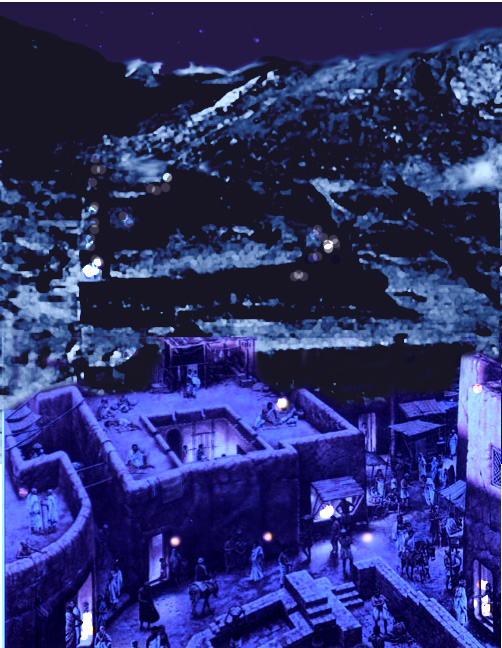 and productively harnessed an active imagination to the yoke of scholarly creative thought. So although she didn’t expect to see a ghostly diorama of moonlit re-creation laid out before her — an ancient town’s crenellated stone-and-mud walls dimly peopled by long-dead shades of priests and goat-herds and potters and children and soldiers and dogs, shouting and tending smoky cooking fires, chasing screeching chickens, drinking wine, dying clothes, writing letters, and tanning hides — she was open to the possibility that the site, seen quite literally in a new light (to use that well-worn cliché she deplored in less careful academic writers) might show her something she hadn’t observed before, something more human than the dry chronological classifications recited by Wilson Rankle in the glare of daylight.
and productively harnessed an active imagination to the yoke of scholarly creative thought. So although she didn’t expect to see a ghostly diorama of moonlit re-creation laid out before her — an ancient town’s crenellated stone-and-mud walls dimly peopled by long-dead shades of priests and goat-herds and potters and children and soldiers and dogs, shouting and tending smoky cooking fires, chasing screeching chickens, drinking wine, dying clothes, writing letters, and tanning hides — she was open to the possibility that the site, seen quite literally in a new light (to use that well-worn cliché she deplored in less careful academic writers) might show her something she hadn’t observed before, something more human than the dry chronological classifications recited by Wilson Rankle in the glare of daylight.
And she was not too stuffy to wish for a time machine to confirm such imaginings, since the methods of archeologists seemed to her, paradoxically, to be both technically sterile and too subjective all at once. Whereas one could easily imagine these walls long ago corralling all the same activities that people engage in today – cooking, lying, loving, keeping secrets, making mistakes, laughing, prevailing, struggling – it was the surprises, the things you’d never guess, that interested Einer Wayfarer. It was in surprises where progress lay in understanding ancient lives, in fleshing out people who lived long ago. Surprises like a jar handle bearing a hidden ambiguous symbol, a painted bee drawn to an exotic flower on a sherd, and a young man whose tapped initial Rs and slightly retroflected Ss were not fully explained by either southern European origin or Scottish influence.
As she moved along the ridge to a better vantage point, she realized she wasn’t alone. Just ahead of her, perched on a flat rock, sat Amit Chayes.
“Does no one around here sleep?” she asked.
“Sleep? It’s still early,” Chayes said, turning. “Erev tov, Einer. Please sit,” he invited her. “Doing what?”
“Seeing what the moon has to show. And you?”
“The same. And the tables were occupied.”
Wayfarer chuckled. “Danish lessons, do you suppose?”
“I can remember being so young, can’t you?” Chayes smiled. “I met my wife on a dig. These things are to be expected — it’s natural.”
“Indeed it is,” Wayfarer said, not answering his actual question, and doubting the pertinence of matrimony in this instance. “In fact, Rory Zohn was just touting the advantage of working within natural systems, although his example was aptitude for cooking, not sex.”
“If camp gossip is true, perhaps in this case it’s related,” Chayes laughed. “Well, I should spend more time in the lab. I didn’t know discussion there was so intellectual, usually.”
“It seems like you’ve put together a fairly good crew.”
“Young, but good,” he agreed. “Pretty good. Some hard workers, some needing a bit more guidance, more experience. As usual. We were lucky: except for Zvia Ben-Tor, who requested to come, our permit came so late the crew was filled in the last minute with overflow from other site applicants.”
“Why is that?”
“The government is preoccupied with the Lebanese events. And so many archeologists are called up for military service at times like this, the Reshut HaAtikot — the IAA — is slowed down to an even less efficient pace than usual. Our small site had low priority.”
“Why are you digging here, Amit?” Wayfarer asked. She looked out over the hill, onto the squares making an orderly framework deeply cut against the pale, stony hilltop. Within the inky pits were dim outlines of walls and floors, none complete, few rectilinear, 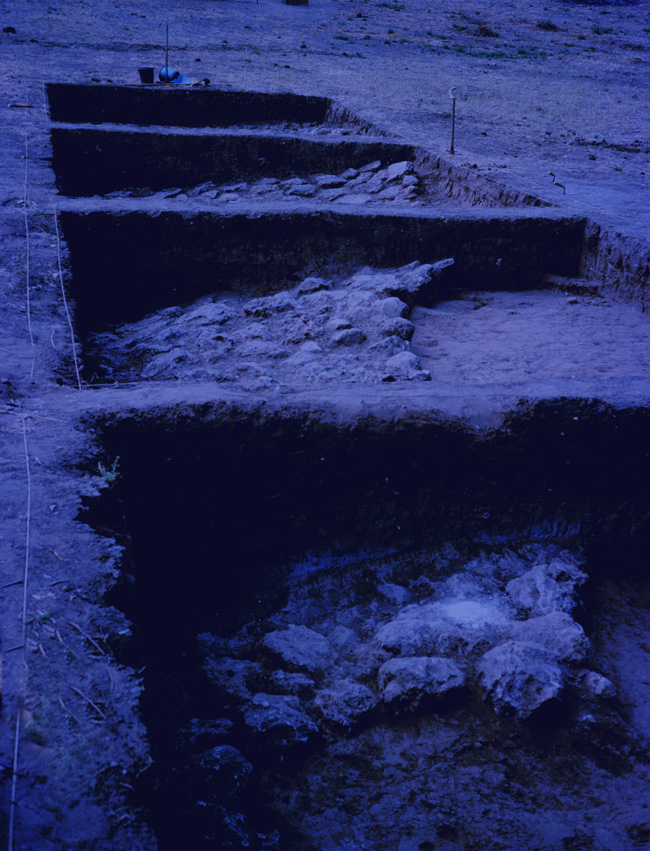 not at all aligned with the carefully surveyed lines of the archæologists’ grid, running their own imprecise, human-laid courses under the sternly oriented, scientifically imposed balks.
not at all aligned with the carefully surveyed lines of the archæologists’ grid, running their own imprecise, human-laid courses under the sternly oriented, scientifically imposed balks.
“Ah, the staff have been complaining to you,” Chayes stated, answering her meaning and not her words. “The simplest answer is archeological: because there are so few remains later than the Bronze Age at the site the Chalcolithic and even earlier levels, if present, should be relatively well-preserved. But also…” He glanced over his shoulder at the sheer cliffs that rose above the site a few hundred meters from where they sat. “I think that the place has… Well, to say it has secrets is too dramatic; all archeological sites have secrets; it’s their nature. So, I will say instead surprises. For instance, I was hoping you’d confirm that character on the amphora handle as wehériəl.”
His words resonated uncannily with her earlier thoughts. “You’re looking for evidence of Elennui culture?” Wayfarer asked. “That is a surprise.”
Chayes shook his head, “No; no, I’m not looking. That’s unsound technique in our field: you almost always find what you look for. But, if it were to show up, that would be a surprise.” He shrugged. “So, I hoped the symbol was evidence that Elennui speakers have lived here.”
Wayfarer cleared her throat. “I wish I could have confirmed it, but…”
The archeologist waved a hand. “No; of course. It was sound scholarship, much more important. And no matter – there is still much dirt to move.”
“Who has lived here?” she asked. Responding to Szeringka’s peremptory summons, Wayfarer hadn’t had time to read site reports, and Rankle’s dull orientation had meant little to her.
Chayes paused before responding. “Do you mean people of the Bible?”
She supposed he was accustomed to that question, perhaps irked by it. She replied, “No, that’s not my bias. I simply mean people. Any people, of any book. Or of no book. Who has lived here?”
“This is Israel – who hasn’t lived here? Over the millenia, this ridge has been occupied by foreign soldiers; nomads from far and near; tale-telling hunter-gatherers with stone tools; well-organized patriarchs with scribes and cisterns, pottery and laws; zionist idealists; entrepreneurial ostrich farmers. Optimistic archeologists. People who left things, and people who are looking for those things. People hoping for secrets – surprises. But the site has kept its secrets well, I would say.”
“So, it’s not a tell…” Wayfarer punned, not sure Chayes’s English was colloquial enough to catch it.
He shrugged and made a literal reply. “Our hill is not a tel, technically. Just superimposed occupation levels along a ridge – most of the topography is geologic, natural – piled up outwash from the upper wadi, now eroding slowly. But I understand your joke – and no; it is not a tell, in any sense. Especially in one way,” Chayes added, “the site has been entirely mute. The staff is right – Beit Bat Ya’anah is missing something.”
Wayfarer waited.
“We’ve sounded, and surface-surveyed across the whole ridge, and even searched downstream in the wadi. It’s a small but enduring habitation: one would expect…” the archeologist broke off, then finished bluntly, “No bones, no teeth. No evidence of burials or any human remains.” He shrugged once 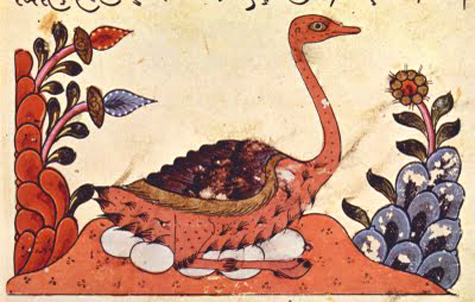 again. “Well, as I say, there is much dirt yet to move.” Chayes turned back to the moonlit walls below, perhaps again hoping to be shown secrets, or at least surprises.
again. “Well, as I say, there is much dirt yet to move.” Chayes turned back to the moonlit walls below, perhaps again hoping to be shown secrets, or at least surprises.
Einer Wayfarer took the hint, and stood to go. But she couldn’t keep from asking one more question. “Ostrich farmers?”
“You don’t know the meaning of Beit Bat Ya’anah?” Chayes asked. “ya’anah is the female form of ya’en, ostrich. The name means ‘House of the Ostrich’s Daughter’. Ask Moshe sometime – he loves to tell that story.”
To be continued…
To read the next installment, Part 13 “Correspondence” click here
Tucson in the rearview mirror: and…
I rolled back into Phoenix from Tucson earlier today — the drive seemed nearly instantaneous and was marvelously uneventful, although I did miss the bumper crop of towering dust devils swirling in the dry creosote flats on the Gila River reservation that I’d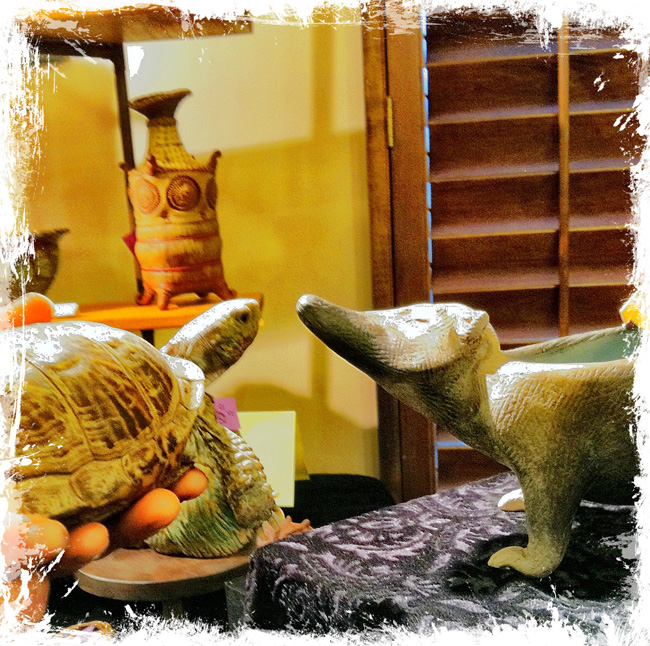 seen on the way down but was unable to photograph safely from the driver’s seat. And the windshield made the trip intact, unlike last time. And once again I failed to stop at the ostrich farm to take pictures as intended, but it was smack in the middle of the day as I zipped by, and it was so damn hot…
seen on the way down but was unable to photograph safely from the driver’s seat. And the windshield made the trip intact, unlike last time. And once again I failed to stop at the ostrich farm to take pictures as intended, but it was smack in the middle of the day as I zipped by, and it was so damn hot…
Emma the (real live) Desert Box Turtle nose to nose with a clay coati >>
So now I’m at home being given Stink Back by the felines, coddling the pool back to cleanliness after a dust storm that hit after I left, and rounding up moribund insect life that had made indoor sport for the same felines in my absence, and the email is working again as inexplicably as it wasn’t working earlier, and things may return to normal soon. The Tucson Bird and Wildlife Festival was a good show, sales-wise, and I got a chance to meet new folks, visit with bird festival friends, and send Three Star Owl pieces off to new homes, which is always a good thing. If you missed the Festival, be sure to  look into it next year. Thanks, Tucson Audubon Society, for a great effort and a well-organized and graciously hosted first-time event!
look into it next year. Thanks, Tucson Audubon Society, for a great effort and a well-organized and graciously hosted first-time event!
Even better, I had some fun with friends — I stayed with Kate, and she and Dustin and I talked and ate good food, and I met JoJo and Dave and saw Bri’s fine octopus (oh, if I’d only gotten a picture: my sub-theme here seems to be missed shots), and netflixstreamed Jim Jarmusch’s film Dead Man, and went to Copper Country resale emporium (see swell carved boxes scored there >>), and ogled their current beading frenzy. As usual I left her home feeling that I’d taken away more than I’d left behind, which was physically true because Kate sent me away with many excellent things like harlequin boxes and an articulated silver 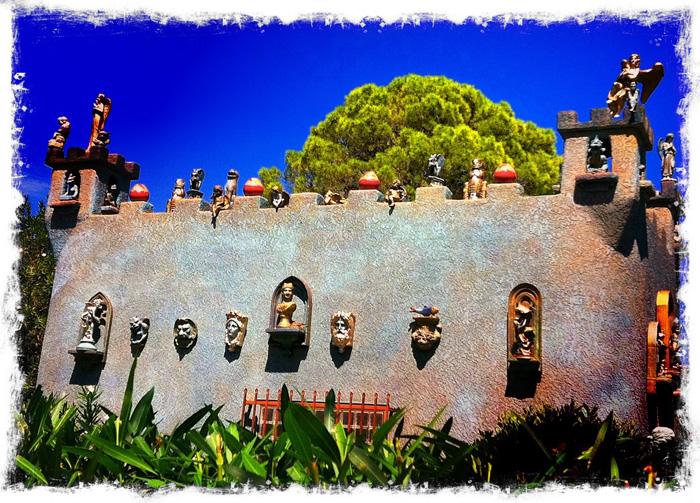 manpart charm (with a chain to pull to make it either alert or waggle), and more. I can’t show you the very special thing that came home with me, because I have to check with Dustin first, and show it to E (for whom it’s intended) but I will later, maybe. And we saw the Gargoyle House >>
manpart charm (with a chain to pull to make it either alert or waggle), and more. I can’t show you the very special thing that came home with me, because I have to check with Dustin first, and show it to E (for whom it’s intended) but I will later, maybe. And we saw the Gargoyle House >>
And now I’ve got to be ready to hit the ground running, because there is a lot to do, like get the owls to their people…
Owl whistle necklaces
Update as of Monday 22Aug: thanks for all of your enthusiastic responses! And thanks to Kate McKinnon for posting them, and loaning me the fine box they were roosting in, too! All the owl whistle necklaces have found new homes — the owl/owl-craver ratio was excellent, and there was only a little disappointment. If you’d like to be contacted when a new batch is ready to go, please email me. If you 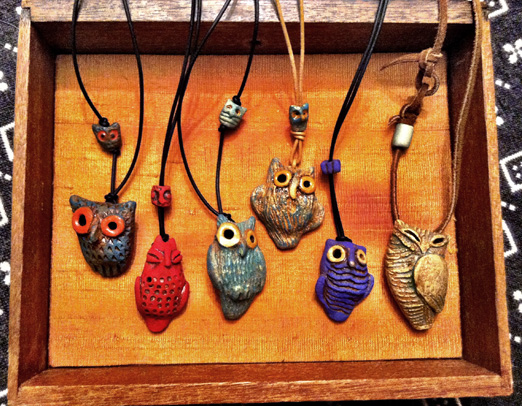 are one of the owl-owners, I will invoice you through PayPal soon after you send me your mailing address, and ship your owl to you after that. Thanks again, everyone!
are one of the owl-owners, I will invoice you through PayPal soon after you send me your mailing address, and ship your owl to you after that. Thanks again, everyone!
Here they are; the six remaining clay “retro” owl whistles from Three Star Owl. They’re all different, and strung either on black faux leather lacing or brown suede lacing. Each has a suitable smaller bead above it. Each necklace is $42, and can be yours if you contact me ASAP on the contact page; it’ll be a first-come-first-served sort of arrangement (perhaps include a second choice?). They’ll be going back into the public eye at the Tucson Bird and Nature Festival tomorrow morning. (Colors in photo are not exactly perfect but fairly close.)
Postcard from Tucson
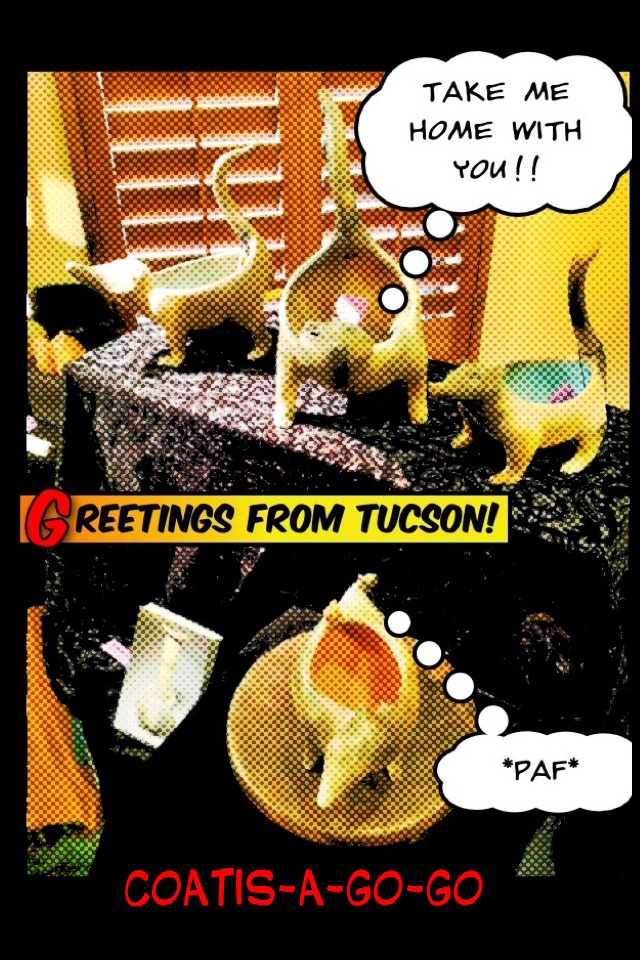 Three Star Owl is at the Tucson Bird and Wildlife Festival, at the Riverpark Inn just west of I-10 at the Congress Ave exit. I’ll be here from 8 to 5 today and tomorrow (Friday and Saturday 19-20 Aug). Come by soon, things are finding new homes at a fast clip!
Three Star Owl is at the Tucson Bird and Wildlife Festival, at the Riverpark Inn just west of I-10 at the Congress Ave exit. I’ll be here from 8 to 5 today and tomorrow (Friday and Saturday 19-20 Aug). Come by soon, things are finding new homes at a fast clip!
Blue moon month for Three Star Owl!
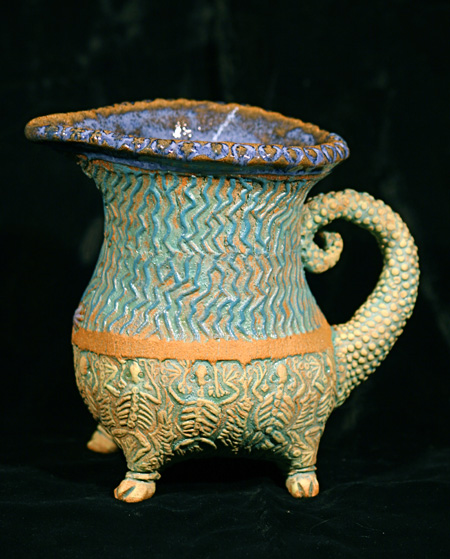 Well, it’s never happened before, but Three Star Owl has two sales events in southern Arizona in less than two weeks!
Well, it’s never happened before, but Three Star Owl has two sales events in southern Arizona in less than two weeks!
Frog skeleton creamer (approx 4″ ht) >>
Close on the heels of the Southwest Wings Festival, Three Star Owl will be at the first ever Tucson Audubon Society’s Tucson Bird and Wildlife Festival this week. The Festival is at the Riverpark Inn just off I-10 in Tucson. On Friday and Saturday from 8am to 5pm I’ll be set up in the Marketplace with other vendors, in the main ballroom right off the lobby of the hotel. For more info about 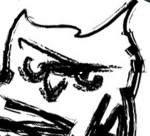 the Festival in general, click here.
the Festival in general, click here.
As usual for birding festivals, there’s no entrance fee for the vending area, so drop in and say hello to Cranky Owlet and check out the wares!
What happened at Beit Bat Ya’anah: part 11
This is the eleventh installment of a series. There’s a link at the bottom of the page to the twelfth installment. Or, to read from the very beginning, click here.
Previously:
“Our other on-going personnel matter,” Amit Chayes had explained about the sound of argument coming  from the mess-tent. “I take full responsibility. I should have hired a cook with more experience, only, it seemed so fortunate to find a site photographer who was willing to cook as well. But we’ve had to re-kasher the refrigerator twice this season. If you’ll excuse me, I should go to mediate.”
from the mess-tent. “I take full responsibility. I should have hired a cook with more experience, only, it seemed so fortunate to find a site photographer who was willing to cook as well. But we’ve had to re-kasher the refrigerator twice this season. If you’ll excuse me, I should go to mediate.”
Natural systems: flowers and bees, pottery and poetry
“Mikka quit?” Rory’s disbelieving shout of laughter caused Einer Wayfarer’s head to snap back upright.
The professor had volunteered to help in the lab after the evening meal partly out of the acerbic goodness of her heart, and because she was interested in seeing how these things were done. Recording data points from Rory’s grimy Area D field notebook onto locus cards proved to be no less mind-numbingly tedious work than the actual digging, so she felt entitled to occupy herself by eavesdropping on the staff’s conversation. That was worth staying awake for – the patois in the group was a casual shakshuka of old world languages, bound together in a matrix of English of several flavors. And it wasn’t really eavesdropping: with a voice as loud as Rory’s, hearing was hardly avoidable in the small, stuffy room. Now conversation had come around to gossip about the afternoon’s kitchen fuss and the absent Dario, who, per Amit according to Zvia, had been appointed as replacement for the unsatisfactorily breezy Mikka.
“She quit on the spot as cook,” Zvi said, “but not as photographer – she’ll be concentrating on site-and-find photography for the last two weeks of the dig.”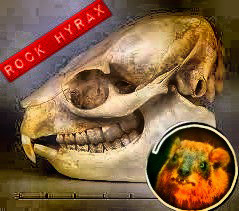
Rory groaned. “What did she do this time?”
“Moshe found the skull of a shafan…” Lior looked at Zvia for vocabulary help.
“Rock hyrax,” she supplied.
“… a hyrax skull on the dairy shelf in the refrigerator,” Lior explained, his forehead crinkled. “Not cool!”
“So they’re yanking Dario off the hill to cook?” Rory moaned. Wayfarer looked over in time to see him pretend to tear out the hair at his temples. “Damn! That leaves me short of slave-labor in Area D.” When he took his big hands away, the brown hanks twisted out to either side like unkempt ram’s horns.
“You’ve got Eric. And Dr. Wayfarer,” Zvi reminded him gently, tipping her head toward the far corner of the room. Rory moaned again, but not quietly enough.
“I can hear you, you know,” the professor pointed out. “And at least I stay awake under your barrage of monotonous numbers,” she told him.
Rory grinned. “It’s true – it’s more than a fair trade. It’s just that your shappO ain’t as quaint.”
Eric, more concerned about academic technicalities than head-gear, wanted to know, “How can they force him to cook? Isn’t he getting credit for excavating?”
“More importantly,” inquired Rory, “does he actually know anything about feeding people?”
Wayfarer heard Zvia make a small noise of modest expertise. Everyone looked at her expectantly.
“Actually,” she said, “they aren’t, he isn’t, and he does.” She explained, “Remember, he’s primarily a lit student, not an archæologist – Amit took him on as a favor for Dr. Szeringka…” (that makes two of us, thought Wayfarer) “…so he’s purely a volunteer, I guess. And Amit said Dario was happy to take over the kitchen. Supposedly he learned English at some school in the UK by working for the whole year as the cook.”
“Scotland,” stated Wayfarer, mostly to herself.
“Yes,” said Zvi, “Amit said Edinburgh, now that you mention it. But I don’t think he sounds Scottish at all.”
The professor shook her head. “He doesn’t; not entirely.” She’d detected a hint of it in the few words he’d said on the hill. “But it’s in the mix.” She didn’t go into detail; no one wanted to hear about rhotic differentiation and epipenthic vowels.
“I thought Dario was Yugoslavian or something,” said Shams, finally looking up from the light table.
“I thought he was Greek,” Eric said. “So what would he know about kosher food?”
“There are Greek Jews, Eric,” Zvia pointed out. “Besides, he’s not Greek. Or Yugoslavian. I don’t think... Anyway Moshe’s given him a crash course in kashrut.”
“Let’s hope that works better than it did with Mikka,” Lior muttered.
Zvi went on. “Anyway, she’s lucky: Rankle and Moshe wanted to fire her completely. But Amit prevailed. To settle the mess, he’s split meal prep up: Dario’s putting out tea and doing the actual cooking – breakfast and the main meal, and chopping veg for dinner. Moshe’s in charge of supper since there’s just putting out the veggies and stuff. Mikka’s doing the washing-up. Plus the photography.”
Rory observed philosophically, “Well, if Mikka can’t de-koshrify the joint by washing dishes –” here Wayfarer distinctly heard Lior and Zvia snort in unison “– and Dario’s better at dinner than digging, I say go with the natural system. It’s more comfortable for everyone.”
“koshrify isn’t a word,” Zvi said instructively. “And, Dario’s not out of the dirt entirely. He’s still supposed to work on the hill when needed, and help with paperwork in the lab.”
“Invisibly?” wondered Shams aloud, looking around theatrically.
Eric giggled, “Now you sound like the Wrinkle…”
Because she felt she was expected to, Wayfarer cleared her throat, simulating perfunctory disapproval. It had an effect: the laughter trailed off, although slowly. Rory and Zvia returned to their sherd-sorting, still snickering. Suddenly Zvi exclaimed, “Oh, hey – cool!” She held up a clay fragment that was decorated with a chocolate brown design on a buffy background. “Nice bichrome.”
Rory said to Lior, “Hey, Pottery Man, did you see this? It came up today, when we were clearing a well.”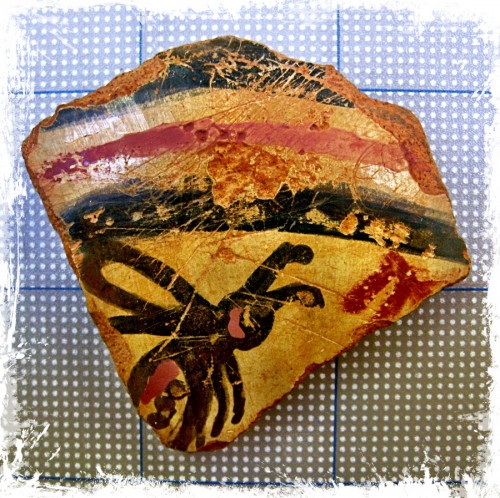
Lior hung over Zvia’s shoulder. “It’s tsir’a, a wasp,” he said. “One of your friends, Eric,” he teased the younger man, who self-consciously raised one hand to his still-welted neck.
“Or devorah, I think, isn’t it,?” Zvia corrected Lior’s biology. “A bee?”
“I don’t think that’s bichrome,” he asserted, counter-correcting.
“Is that a flower? Too bad it broke right there; it looks like a foxglove.” Zvi brought the sherd to Wayfarer. “Did you want to see? We bring up so little decorated pottery at BBY.”
“Or anything else of interest…” the draughtsman muttered over his precisely inked site plan. Wayfarer noticed that no one laughed.
Zvia said, “If it’s not an articulated masonry wall, Shams has no use for it. Although it’s true, BBY hasn’t been the most productive site, so far, either in small finds or architecturally.” She was still holding out the sherd. The professor obediently regarded the small scrap of scuffed clay, only slightly more colorful than the dirt it came out of: she saw there was indeed a bee painted there, wings spread in flight. In front of it the blunt end of a phallic-shaped object just pushed into view from one of the broken edges – Zvia’s “foxglove”.
“The clay body’s too red for bichrome…” Lior was saying, intent on his ceramic thought process. He had trailed Zvi across the room, and was now studying the piece in Wayfarer’s hand.
“A flower? Looks like a cigar to me,” joked Eric.
Lior muttered, “And I’ve seen birds and bulls and ibexes on bichrome, but…”
“Everything looks like a cigar to you,” said Shams, to Eric.
“…but never insects, or flowers…” Lior reached for the sherd and Wayfarer placed it in his palm.
“Sometimes a foxglove is just a foxglove…” she said, standing. To her, the “flower” looked like a geometric space-filler, a result of a Bronze Age potter’s horror vacui. She pushed in her chair to leave: the younger folk, archæologically fervent, were now hotly debating whether the piece was really bichrome and if not, what. She wished them goodnight, and received a polite layla tov in return.
Wayfarer left the lab mulling over the chip of colored clay displayed in Zvi’s square, grubby palm: its date and technical description were for the experts who cared about such things, but the possible flower and bee motif interested the professor, whose efficient 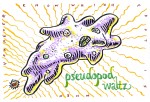 memory had shuffled to the surface a handful of lines of fragmentary but appropriate verse. Wandering out across the dark compound, the professor wondered where the foxglove nearest to this arid, rocky ridge grew: probably, she concluded, the Pleistocene.
memory had shuffled to the surface a handful of lines of fragmentary but appropriate verse. Wandering out across the dark compound, the professor wondered where the foxglove nearest to this arid, rocky ridge grew: probably, she concluded, the Pleistocene.
To be continued…
To read the next installment, Part 12 “The Nature of the Hill” click here.
A new Spot the Bird… kind of
Well, it’s not actually a bird. Perhaps these posts should be called “Not the Bird”. 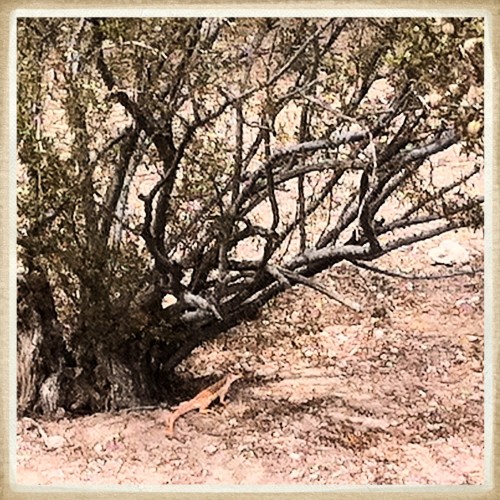
Here is an appropriately faded Old West-y snap shot of a neighbor of ours, taken with my cell phone. Can you spot the non-avian subject? It’s a Desert Iguana, posing with dignity as if for a Victorian formal portrait, lurking in the heat of the day under a creosote bush a block from our house.
<< Desert iguana under creosote (photo A.Shock). Click once to enlarge.
These lizards are both camera-shy and fast, and this was the best shot I could get: right after clicking it, the liz shot off across the broiling pavement back to the other side of the road and disappeared.
Desert iguanas (Dipsosaurus dorsalis: “thirsty lizard” with a “notable back”) are fairly large lizards — this one was twelve inches from nose to tail-tip — closely associated with creosote bushes, which provide them with food, shelter, and shade. I’m always thrilled when I see one in our ‘hood, which is only a couple of times a year. Unlike our other local lizards who eat other creatures and shun the heat of the day by retreating to shelter and burrows, these pale pinkish, blunt-nosed lizards are primarily vegetarian thermophiles who are most frequently seen active and out in the heat of the day in the very hottest part of the summer. This one was basking on the edge of our black-asphalt street, swishing its long tail slowly back and forth before it fled the camerazza (me). Click here for an earlier Three Star Owl post on our neighborhood iguanas, here for more species info, and here for still more info and great photos. If you’re too blasé to click the second link, you will miss reading about this species’ interesting natural history, including why it eats the fecal pellets of other iguanas, and what its thigh glands secrete. Really, you need to know, so go ahead and click.
Fasten your seatbelts…
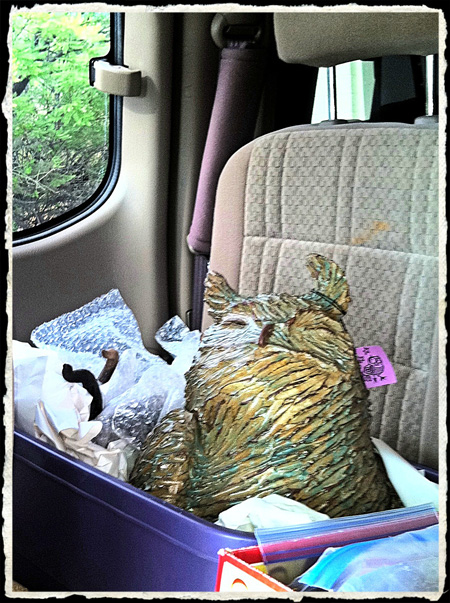 ….Three Star Owl is hitting the road!
….Three Star Owl is hitting the road!
For three days — Thursday, Friday and Saturday August 4, 5, and 6 2011, I’ll have a booth at the Southwest Wings Birding and Nature Festival in Sierra Vista, AZ.
For more info about the festival, click HERE.
<< VLO (Very Large Owl) effigy and a couple of coati tails.
Special Note: THERE WILL BE OWLS. Also, lots of mugs: hummers, horned lizards, corn, ravens, and more!
Hope you can make it!

